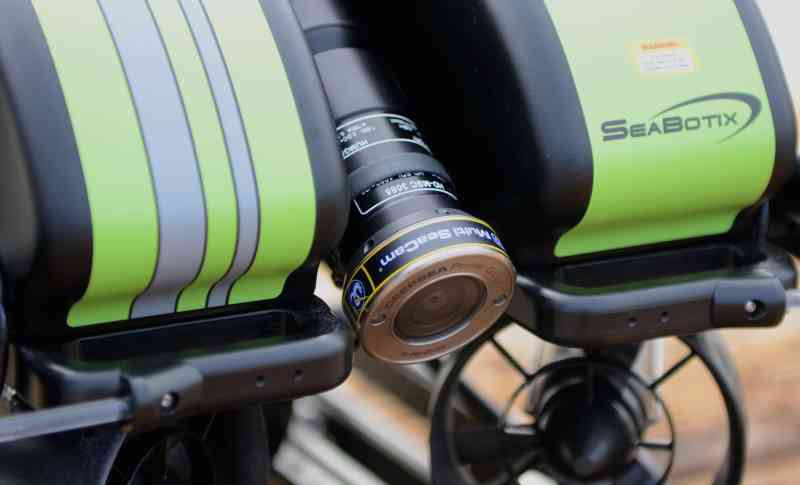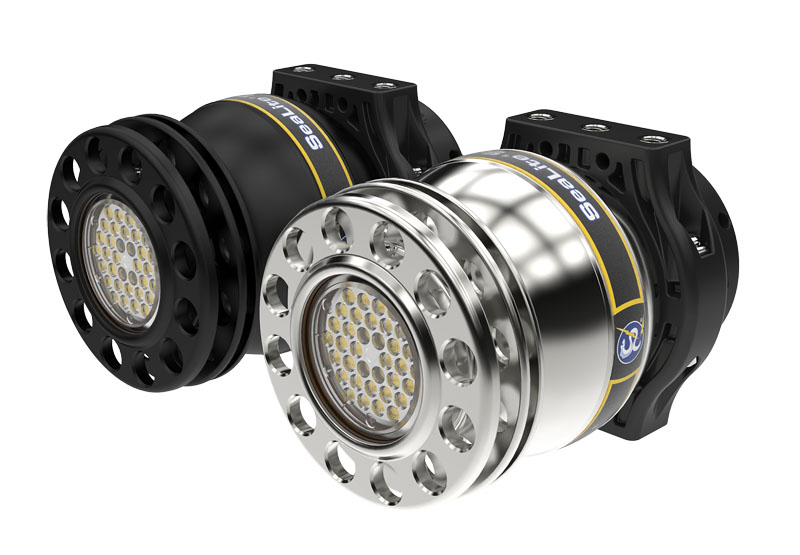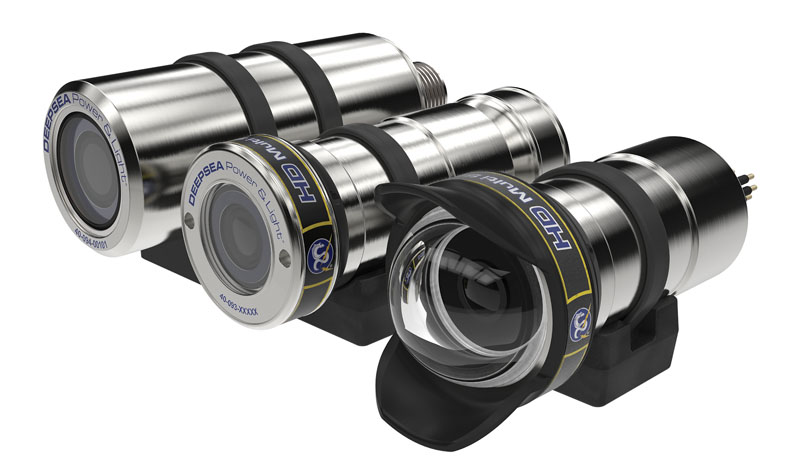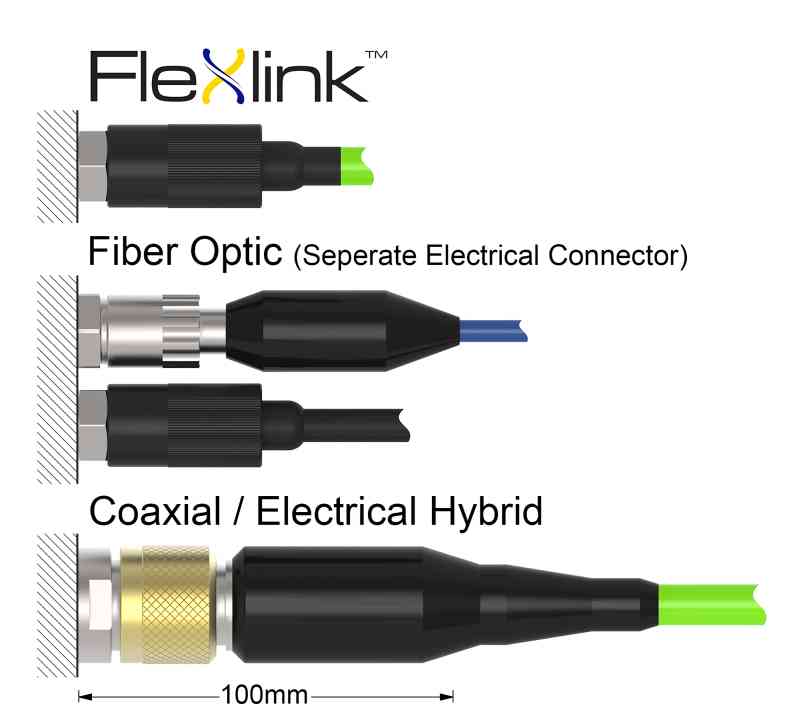March - Feature Story
Advancements in Subsea High Definition Imaging
By: Brian Braden, Sales Engineer with DeepSea Power & Light

DSP&L’s HD Multi SeaCam(R) mounted on Teledyne Seabotix vehicle.
DeepSea Power and Light (DSP&L) has been an innovative leader in the oceanographic community for over 30 years. Their unique approach is focused on technology solutions to provide quality products that stand up to the rigors of harsh subsea environments over time
Starting in his garage in 1983, Scripps Institution of Oceanography Ph.D. student Mark Olsson created DSP&L’s first product, the SeaBattery™ power module. Capable of supplying stable and reliable power at full ocean depth, this product remains widely utilized worldwide over 30 years later. DSP&L’s collaborative and creative approach to product design put them in the position to engineer custom lighting for the Titanic expeditions. Product designs that push the technological boundaries of their time continue to be among DeepSea Power & Light’s core strengths.
Performance Under Pressure
DSP&L emphasizes a beyond-minimum approach, commonly designing products to withstand depths beyond existing industry limitations. The team is guided by several basic principles when creating any new product design: performance, immersion longevity, durability, and compact form factor are just a few of the underlying concepts considered a necessity for any product that bears the DSP&L name. Examples of this include sapphire crystal ports used in place of glass or acrylic; titanium housing options, and industry-leading miniaturization of lights and cameras. The DSP&L design approach ensures that products will perform where and when needed while minimizing costly down-time. This has resulted in the design of the industry leading LED SeaLite® Sphere family of lights. Flicker free and fully dimmable, these units are capable of outperforming a 400 watt Metal Halide (HMI) at a fraction of the price and size.

6km Hard-Anodized Aluminum & 11km Titanium High Output SeaLite(R) Sphere Lights.
Beyond the simple physical design properties of a product, the philosophy of quality without compromise extends to the entire production process. All products receive comprehensive quality checks throughout every stage of assembly and every single product undergoes pressure testing to or in-excess of advertised depth rating. Instead of relying upon the LED manufacturer-provided performance specifications, every light is individually evaluated after assembly in a 1 meter integrating sphere for true color-temperature reading and luminous output. This commitment to quality has led DSP&L to the forefront of what is possible in lighting and imaging solutions.
The High Definition Camera Evolution
Among its contributions to subsea imaging technology, DSP&L strives to enable new applications for HD video. This includes the HD Multi SeaCam® family of cameras: the industry’s first full-HD tooling camera with integrated coax and fiber optic outputs. The compact size of the HD Multi SeaCam tooling camera enables integration of HD video on smaller platforms and in a wider variety of placements than previously possible; including manipulator arms, pan and tilt units, and smaller ROVs. As well as for tooling purposes, the wide angle view on these cameras creates a new class of HD context cameras providing pilots with full operational awareness. In 2015 DSP&L is continuing this innovative drive with the announcement of the industry’s most compact full HD optical zoom camera and their innovative FleXlink™ HD-SDI transmission technology.

(Left to Right) 4x HD Zoom, HD Multi SeaCam(R) with Fiber Optic, and HD Dome Port with FleXlink ™ .
The FleXlink Advantage – Hassle Free HD
Existing coax and fiber optic interconnects are bulky, expensive, and delicate compared to the compact and robust HD Multi SeaCam tooling camera. In order to decrease the footprint, improve reliability, and reduce operation costs for HD video systems, DSP&L engineered their FleXlink technology: a HD-SDI transmission solution utilizing existing Ethernet interconnects.
By taking advantage of the controlled impedance of twisted pair Ethernet cable, FleXlink sends full bit-rate, uncompressed HD-SDI formatted video over distances of 10 meters through existing subsea connectors and cables. A FleXlink media converter, placed in an existing multiplexer (MUX) or dedicated housing, converts the signal to either a coax or fiber optic HD-SDI output by means of a Small Form-factor Pluggable (SFP) module. With a compact size of just 63mm x 40mm (about the size of a typical business card), the FleXlink media converter can fit into even the most crowded multiplexer configurations. As the FleXlink board outputs either coax or optical HD-SDI data, no additional hardware is necessary to connect with commonly utilized multiplexing hardware.
There are numerous advantages to the FleXlink approach, all gained without increase in cost when compared to a camera that is equipped with a conventional HD-SDI interconnect method. The flexible nature of existing Ethernet cable and its pervasive use for other instruments are among the primary benefits. No longer are bend radii such a limiting factor as Ethernet cable can tolerate bends to a much greater extent than fiber optic or coaxial cabling, especially beneficial on dynamic installations such as pan&tilt units and manipulator arms. Additionally coax and fiber interconnects contribute 15cm or more to overall product length, not including cable bend radius restrictions. Standard Ethernet connectors are significantly more compact in comparison and available in a wide range of form factors including low-profile solutions. FleXlink also reduces maintenance and spares costs by leveraging commonly utilized Ethernet interconnects and cables. The standardized SFP module on the FleXlink media converter provides the added benefit of being able to swap out the SFP module to change optical wavelengths as systems are modified over time. This benefit is attained without the added burden of requiring factory service of the camera itself. With the current economic environment of the industry never far from the mind, FleXlink is poised to provide increased mission capability to existing platforms while reducing both capital and operational expenses required for HD imaging solutions.

Comparison between FleXlink™ (Ethernet-type), fiber optic, and coax solutions. FleXlink allows more compact and robust HD-SDI video connections.
Looking Forward
DeepSea Power & Light is committed to pioneering technologies that increase product utility, performance, durability, and value. Solutions driven by technological capabilities are developed alongside demands from industry leaders. The FleXlink solution is the latest example of a DSP&L offering to provide greater earning potential to system operators while reducing long-term costs. This trend continues with the upcoming release in 2015 of its 4x Optical Zoom HD Camera, available with the FleXlink solution.
DeepSea Power & Light’s philosophy of innovation and quality will bring new products with unique capabilities to the subsea marketplace for years to come.

